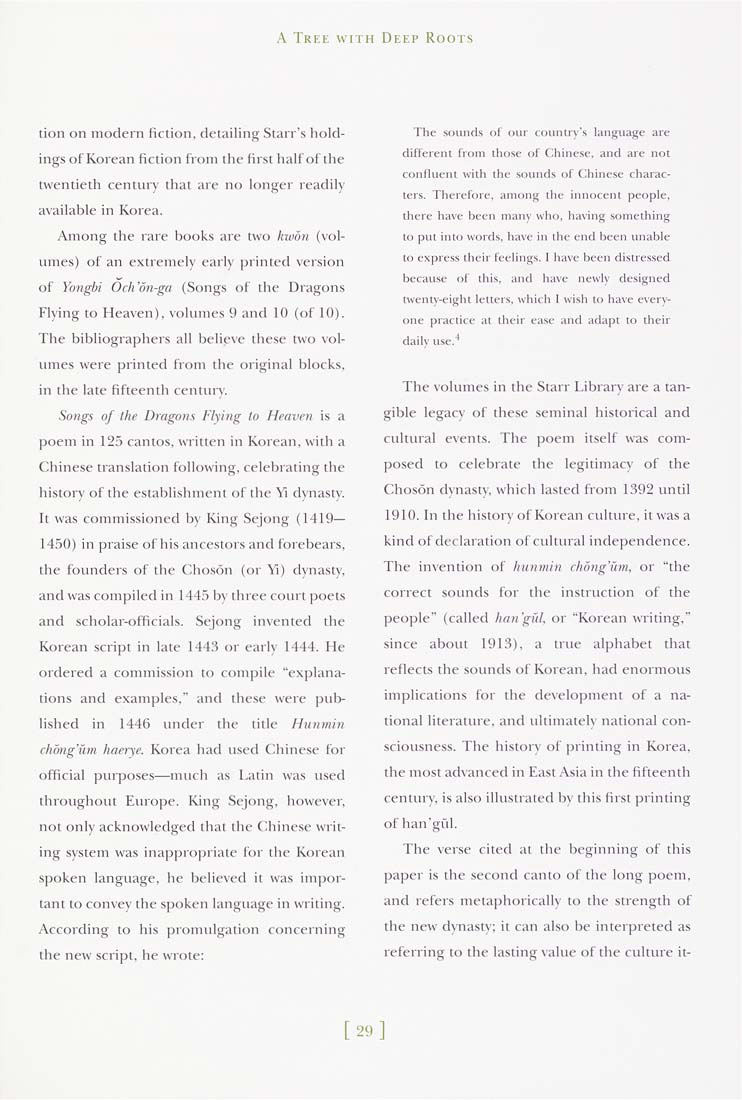Columbia Library columns (v.45(1996))
(New York : Friends of the Columbia Libraries. )
|
||
|
|
|
|
| v.45,no.1(1996:Spring): Page 29 |

A Tree with Deep Roots
tion on modern fiction, detailing Starr's hold¬
ings of Korean fiction from the first half of the
twentieth century that are no longer readih'
available in Korea.
Among the rare books are two hnon (vol¬
umes) of an extremely early printed version
of Yongbi Och'on-ga (Songs of the Dragons
Flying to Heaven), volumes 9 and 10 (of 10).
The bibliographers all believe these two vol-
tmies were printed from the original blocks,
in the late fifteenth centur\'.
Songs of the Dragons Flying lo Ileaiien is a
poem in 125 cantos, written in Korean, with a
Chinese translation following, celebradng the
history of the establishment of the Yi dynast)'.
It was conmiissioned by King Sejong (1419—
1450) in praise of his ancestors and forebears,
the fbtmders of the ("hoson (oi' Yi) d\'nast\;
and was compiled in 1445 by thiee court poets
and scholar-officials. Sejong invented the
Korean script in late 1443 or early 1444. He
ordered a commission to compile "explana¬
tions and examples," and these were ]>ub-
lished in 1446 untler the title liunmin
chbngTim haerye. Korea had used Chinese foi"
official piu'poses—nuich as Lalin was used
throughout Europe. I^ng Sejong, however,
not only acknowledged that the Chinese writ¬
ing system was inap|jropiiate for lhe Korean
spoken language, he believed it was impor¬
tant to convey the spoken language in writing.
According to his promulgation concerning
the new script, he wrote:
The sounds of our country's language are
different from those of Chinese, and are not
confluent with the sounds of Chinese charac¬
ters. Therefore, among llie innocent people,
there have been inany who, having something
to put into words, have in the end been unable
to express their feelings, I have been distressed
because of this, and have newly designed
t\venty-eight letters, which I wish to have every¬
one practice at iheir ease and adapt to their
daily use.
The volumes in the Starr Librarv are a tan¬
gible legacy of these seminal historical and
cultural events. The poem itself was com¬
posed to celebrate the legidmacy of the
Choson dynasty, which lasted from 1392 until
1910. In the histor)- of Korean culime, it was a
kind of declaration of cultural independence.
The invention of hunuii)i chong'um. or "the
correct soimds for the instrtiction of the
people" (called han'ghl. or "Korean writing,"
since about 1913), a true alphabet that
reflects the sotmds of Korean, had enormous
implications for the de\'elopment of a na¬
tional literature, and ultimately nadonal con¬
sciousness. The history of printing in Korea,
the most advanced in East Asia in the fifteenth
centuiy is also illustrated bv this first printing
of han'gi"il.
The verse cited at the beginning of this
paper is the second caiUo of the long poem,
and refei's metaphoricalh' to the strength of
the new dynasty; it can also be interpreted as
referring to the lasting value of the culture it-
29
|
| v.45,no.1(1996:Spring): Page 29 |







